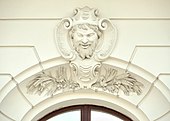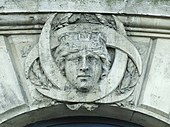Mascaron (architecture)

In architecture, a mascaron ornament is a face, usually human, sometimes frightening or chimeric whose alleged function was originally to frighten away evil spirits so that they would not enter the building.[1] The concept was subsequently adapted to become a purely decorative element. The most recent architectural styles to extensively employ mascarons were Beaux Arts and Art Nouveau.[2][3] In addition to architecture, mascarons are used in the other applied arts.
Gallery[]
Mascaron above a door from Paris

Details of the ancient frieze of the Portico of Tiberius (Aphrodisias, Turkey)

A Green Man corbel supporting the Bamberg Horseman, in the Bamberg Cathedral (Bamberg, Germany)

The Three gorgons on the Secession Building from Vienna (Austria)

Chandelier with mascarons, circa 1710-1715, in the Metropolitan Museum of Art (NYC)
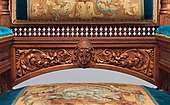
Mascaron on a chair, circa 1875-1876, in the Metropolitan Museum of Art
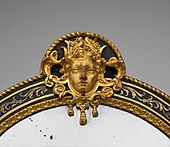
Mascaron on the frame of a dressing table mirror, circa 1700, in the Metropolitan Museum of Art

Sculpted mascaron on the Palais Rohan (Strasbourg, France)

Mascaron above an oculi window upside an Art Nouveau door in Strasbourg

Art Nouveau mascaron from Paris

Mascaron on a corbel in Paris

Jugendstil straight-lined mascaron in Riga (Latvia) from 1906

Mascaron of the Central Bank of Russia, from Moscow
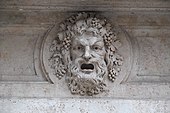
Mascaron on the Hungarian State Opera House, in Budapest

Mascaron of Hôtel du Commandant Militaire (Dijon, France)
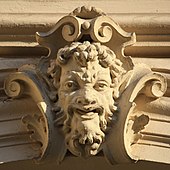
Combination between a mascaron and cartouche, on the Staroměstská tržnice from Prague (Czech Republic)

Mascaron with a swag, on the Berlin Cathedral (Germany)

Mascaron on the Castle of Enghien from the Parc d’Enghien from Belgium

Mascaron of the head of a satyr, 28 rue Louis-Paufique, Lyon
See also[]
References[]
- ^ "mascaron". Oxford Reference. oxfordreference.com. Retrieved 6 September 2016.
- ^ "BUCHAREST 1870S MASCARON". casedeepoca.com. Retrieved 6 September 2016.
- ^ "Art Nouveau in faces: fantasy world of "New art"". essenziale-hd.com. May 29, 2013. Retrieved 6 September 2016.
- ^ Mascarons de Bordeaux (fr.wikipedia)
External links[]
| Wikimedia Commons has media related to Mascarons. |
- Architectural elements
- Reliefs
- Mascarons
- Architectural element stubs



















